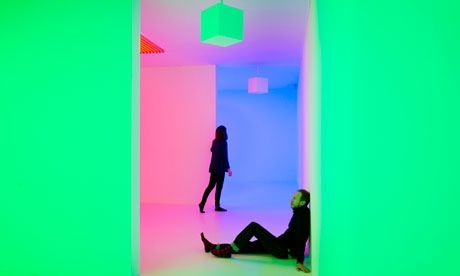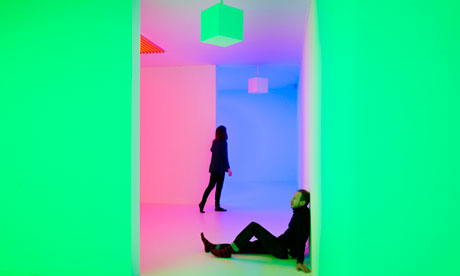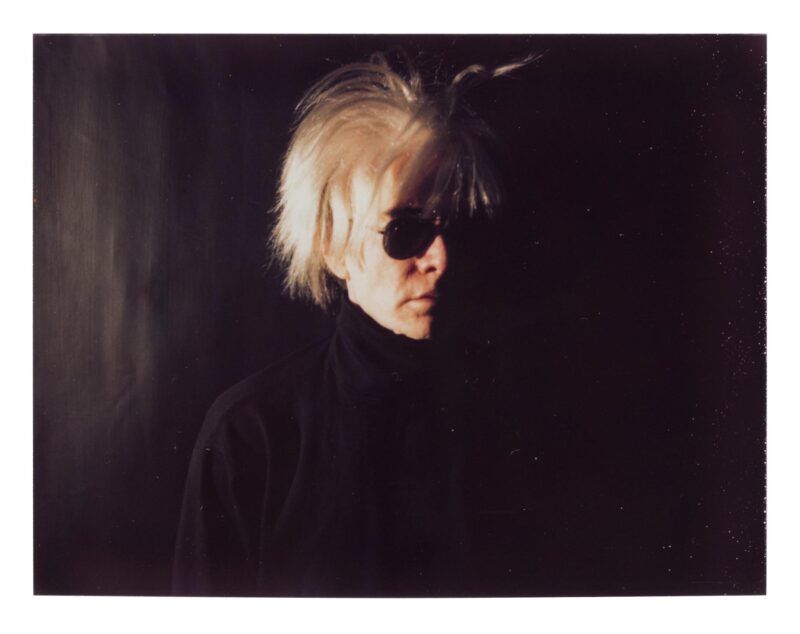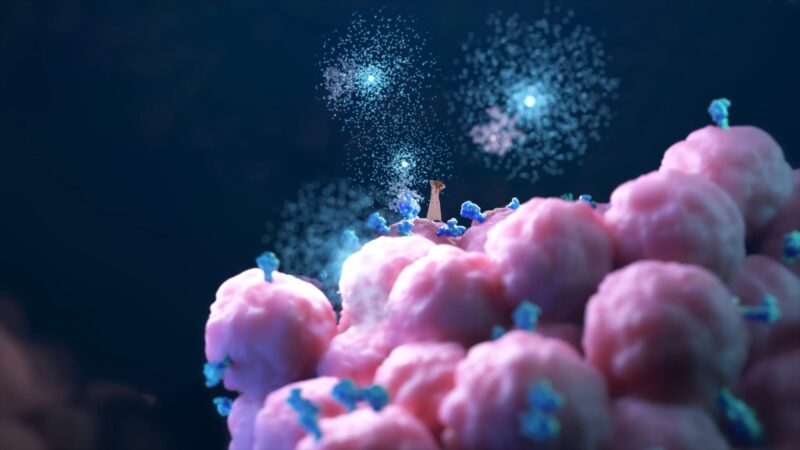
Carlos Cruz-Diez’s Chromosaturation (2008), part of Light Show, at the Hayward Gallery, London. Photograph: Linda Nylind
Tall columns of light are pulsing and throbbing, brightening and dimming in accordance with messages dictated during seances with ouija boards and translated into a poem by James Merrill. You don’t need to know all that, though, to get the feeling that there is some hidden force at work in Cerith Wyn Evans’s electrifying light sculpture. Meanwhile, nearby, a white fluorescent scribble by François Morellet rises from the floor like a dancer frozen in mid-move.
Light Show, at the Hayward Gallery in London, is both spectacle and lesson in colour, optics, perception and technology. Here’s one of Anthony McCall’s cones of light, crossing the room in a bath of artificial haze. Where the cone hits the wall, an evolving line of white light slowly draws a broken ellipse. But the fun part of McCall’s work is the sci-fi haze, the sense that light has been made solid and the way spectators get caught up in the mist – like dancers silhouetted at a disco. The Hayward would make a wonderful dance venue.
At worst, Light Show is a funfair of more or less startling effects. At its best, it is captivating. Fischli and Weiss’s tiny projection Son et Lumière is nothing more than the light from a torch refracted through a patterned plastic cup rotating on a motorised cake-stand. Step through Carlos Cruz-Diez’s interconnecting rooms – lit red, blue and green – and you soon become aware that perception fluctuates. Our eyes tire of a single colour. Receptors switch off and the brain struggles to compensate. Suddenly, the green in this room flares into yellow, then the colour dies. How dirty my eyes are, I suddenly realise, as little squiggles and blobs cross my field of vision. Paris-based Venezuelan Cruz-Diez’s Chromosaturation (1965-2013) is better than any treatise on colour theory, and makes you supremely aware of the act of perception. It is also enormous, instructive, discombobulating fun.
“Due to limited capacity,” reads a notice at the entrance to a dark corridor, “visitors may have to queue. Please allow 15 minutes viewing time to experience the work’s full effect.” Beyond is a very dark room containing a floor-to-ceiling proscenium; and beyond that another room, screened by a translucent, angled wall, everything suffused in deep red. It is hard to get one’s bearings. I stand, I sit, I wait. The red glow dulls, the receptive rods in my eyes sated by the one-colour diet of James Turrell’s installation Wedgework V, from 1975. But wait, there’s a bit of cooler blue blossoming on the left. Wait some more (if 15 minutes doesn’t do it, try an hour, or sit there till you get turfed out) and something terrifying appears. It begins as a dark bruise, a visual conundrum, slowly solidifying into a form so tenuous and horribly present you might never recover from witnessing it. I imagine a movie about an artist, caught up with games of perception, who accidentally opens a portal to an unseen world, letting the bad stuff flow in.

Ceal Floyer’s Throw, on the other hand, takes but an instant to see. A theatre light on a tripod projects a shape on to the floor: a cartoonish splat, like a puddle of paint or spilt milk. It’s a sight gag, and comes as a relief after Leo Villareal’s Cylinder II, in which twinkly lights rise and fall like bubbles in a glass, making patterns and fields of stars. Somewhere in the heart of this cylinder, larger shapes appear, spreading and contracting. Then it all goes sparkly again, like the stars you see when someone has punched you in the face. Villareal’s light sculptures are often installed on facades or inside buildings. They pacify the mind while giving it something to look at, like the fish tank at the dentist. This is hi-tech visual Muzak, unless I’m missing something.
“The sun is God,” JMW Turner supposedly announced on his deathbed. Nothing so pure as sunlight falls in the Hayward. Every artwork needs a plug – or many plugs, plus extensions, in the case of David Batchelor’s re-creation of a Las Vegas sunset, projected on to a wall via a tower of scavenged lightboxes, coloured sheets, fluorescent lights, cables and plug-boards. The garish colour of this polluted Nevada sunset leaks and flares around Batchelor’s tower of electrical dreck. It’s a nice corrective to all the computer-assisted swarms of LED lights and sophisticated tricks elsewhere.
With more than 20 artists, Light Show is filled with optical gimmicks, things that monkey with your eyeballs. Other works, such as Jenny Holzer’s LED column of texts – taken from official US government documents, detailing operations, interrogations and abuse at Guantánamo – seem out of place. Sometimes, the show feels too much of a compendium, although occasionally there’s a moment of wonder. Katie Paterson fills a small room with artificial moonlight, by way of a specially manufactured lightbulb. The light dangles, coldly, and our shadows loom around us. It is like “the vacant interlunar cave” John Milton wrote of in Samson Agonistes.
At the end comes a room of yammering strobe lights, illuminating a long wide shelf. Water spouts from the shelf in sprightly arcs and churning gouts, filigree fountains and chugging spume, all immobilised in the flickering strobes. The water seems solid, its droplets and globules caught and hanging in the otherwise darkened room. The effect of Ólafur Elíasson’s Model for a Timeless Garden is pure magic, simple yet infinitely complex. Suddenly I am caught in the light along with the water, transfixed, supremely aware not just of light but of time and my presence in the world.
guardian.co.uk © Guardian News & Media Limited 2010
Published via the Guardian News Feed plugin for WordPress.







